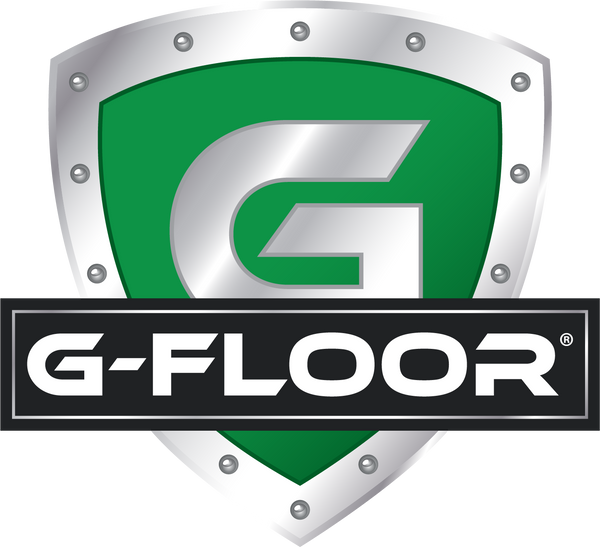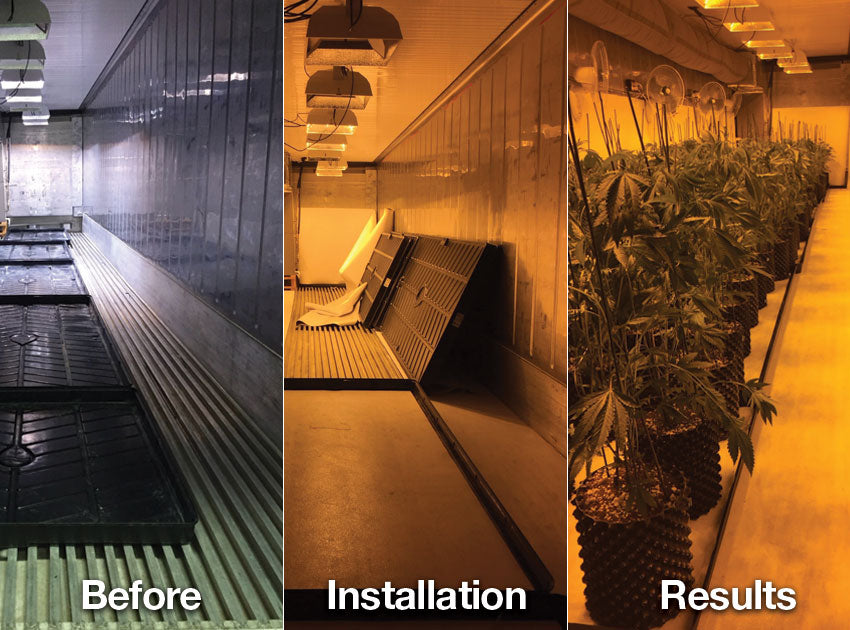Way to go! You’ve chosen the best flooring for your cannabis grow room and now you’re ready to reap the benefits of your new GrowFloor® greenhouse floor. Here’s what you need to know to ensure your successful vinyl grow room flooring installation.
1. Is GrowFloor easy to lay down?
The great thing about GrowFloor is its ease of installation. Just unroll vinyl sheet grow room flooring and trim to fit. No adhesive is necessary unless you want a permanent flooring install for your gardening space. GrowFloor is purposefully-designed for repositioning, reusing and recycling.
GrowFloor is available in Absolute White with a Ceramic™ texture and high-gloss top coat in the following sizes:
- 5' x 10'
- 7.5' x 15'
- 10' x 61'
With these sizing options, you can use GrowFloor as a gardening mat where you work most often for cushioned anti-fatigue support and greenhouse floor protection. Or use greenhouse flooring rolls to pave a pathway through your growing area and protect the substrate from excessive wear and tear and heavy equipment movement. You can also turn to GrowFloor for complete grow room floor covering to guard against moisture, mold, mildew, chemical spills, microbes and other harmful crop contaminants. By covering grow room wall to wall, you create a sterile, lab-like environment for your cannabis plants to prosper.
2. What tools do I need for floating greenhouse flooring install?
Because GrowFloor is made of 100% solid polyvinyl, it is a flexible, lightweight grow room flooring material that is simple to cut. We recommend having these items available:
- Utility Knife and straight edge – for cutting around poles and other permanent fixtures
- Wide push broom – to push out air
3. What do I need to do to prep growroom floor before installation?
Begin by sweeping greenhouse floor clean of debris before unrolling GrowFloor. Wipe up any water, oils, chemicals, etc. from the subfloor. No matter what installation method you choose, loose lay or permanent, starting with a clean, dry subfloor is imperative to success. In most cases, the greenhouse vinyl flooring product is rolled on a PVC or paper core. The product will initially have curl marks – this is normal and will eventually lay flat after resting. The warmer the conditions, the quicker the curl marks will straighten out.
If the floor is uneven or there are large holes or gaps, we suggest filling and leveling if possible. Some large imperfections will show through after the final installation.
4. Is there a proper way to unroll the vinyl flooring?
For best results, start unrolling process at the greenhouse or grow room entrance, finishing at the back of the room. Using a wide push broom, push any air out from the center and work your way outward side-to-side and length-to-length. It will take some time for most curl marks to lay flat. In cool conditions, it may take 72+ hours before all curls have relaxed. Depending on the temperature, the product may expand or contract somewhat during the process. It is okay to start using GrowFloor right away.
5. Can I permanently install GrowFloor with glue?
Yes. You can definitely permanently install vinyl roll out flooring in grow rooms. If you prefer to permanently install for added protection from water, don’t settle tor an adhesive that isn’t tailored specifically to your unique GrowFloor product. For wood substrates, we sell:
G-Floor® Marine & Outdoor Adhesive in the following sizes:
- 1 gallon – covers a 400 sq. ft. area
- 4 gallon – covers an 800 sq. ft. area
G-Floor Marine & Outdoor Adhesive is the only choice to guarantee your floor looks its absolute best after it is installed. Our specially-formulated adhesive is a high-strength, water-based, UV-stable bond that can be used indoors or outdoors for a multitude of grow room and greenhouse applications. It will permanently bond in about 1 hour.
For other substrates, please use the appropriate adhesive for that subfloor, i.e. concrete, aluminum.
6. What tools will I need to adhere grow room flooring?
We always recommend following GrowFloor’s installation instructions that come with your product purchase. Also, read the adhesive manufacturer’s directions as well:
Additional Tools Needed:
Notched trowel size 1/16 in. x 1/32 in. x 1/32 in
75-100 lb. roller
7. What if I want to install GrowFloor as a wall-to-wall grow room cover?
Multiple GrowFloor grow room mats may be used to cover an entire gardening floor. You may butt two together or use Seam Tape to join two or more pieces of GrowFloor together. G-Floor® Seam Tape creates a bond along the underside of the seam where two greenhouse floor mats meet.
GrowFloor Seam Tape comes in:
- Black – 4” wide x 10' and 4” wide x 30 yards
- White – 4” wide x 10” and 4” wide x 30 yards
Our unique Seaming Tape is constructed of strong fiberglass cloth with an acrylic adhesive that creates a like-permanent, durable bond between multiple mats. The Tape has adhesive on only one side, so it bonds on the underside without adherence to the floor. Should you wish to separate mats in the future, simply cut through tape without damaging your polyvinyl mats. Seam Tape won’t stretch in high heat and withstands extreme cold. Simply cut with a utility knife.
8. Can I use GrowFloor as outdoor greenhouse flooring?
GrowFloor may be installed in an outdoor greenhouse or grow room. When installing outdoors, it is recommended to fully glue down the flooring using an appropriate adhesive for the substrate. Please review warranty prior to purchasing for outdoor use.
Innovative GrowFloor greenhouse and growroom floor covering is changing the way cannabis growers of all kinds cultivate a heartier marijuana plant and crop. It’s time to get started growing cannabis faster, bigger and better with easy to install and maintain GrowFloor flooring for cannabis grow rooms and greenhouses!

